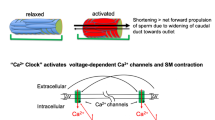Abstract
In the gypsy moth, Lymantria dispar, release of sperm bundles from the testis into the upper vas deferens (UVD) and subsequent transfer of sperm bundles into the seminal vesicles (SV) occurs in a daily rhythm. The UVD undergoes different types of contractions despite the fact that its musculature appears to receive no innervation. Patterns of the UVD movements were recorded throughout the daily sperm release and transfer cycle. In males kept in light-dark cycles, transfer of sperm from the UVD to the SV was accompanied by a characteristic pattern of UVD contractions of high frequency and amplitude. In males kept in constant light, which fail to transfer sperm, this contraction pattern was absent. It is concluded that the vas deferens muscles undergo daily changes in contraction pattern in phase with the light-dark cycle. The increased muscular contractions appear to be a causal factor in the gated sperm transfer from the UVD to the SV.
Similar content being viewed by others
Abbreviations
- LD :
-
light-dark
- LL :
-
constant light
- SV :
-
seminal vesicle
- UVD :
-
upper vas deferens
References
Arikawa K, Uchiumi K, Eguchi E (1991) Extraocular photoreceptors in the last abdominal ganglion of a swallowtail butterfly, Papilio xuthus. Naturwissenschaften 78: 82–84
Bell RA, Owens CD, Shapiro M, Tardif JR (1981) Mass rearing and virus production. In: Doane CC, McManus ML (eds) The gypsy moth: research towards integrated pest management. USDA Tech Bull 1584 (Washington DC), pp 599–655
Giebultowicz JM, Bell RA, Imberski RB (1988) Circadian rhythm of sperm movement in the male reproductive tract of the gypsy moth, Lymantria dispar. J Insect Physiol 34: 527–532
Giebultowicz JM, Riemann JG, Raina AK, Ridgway RL (1989) Circadian system controlling release of sperm in the insect testes. Science 245: 1098–1100
Giebultowicz JM, Ridgway RL, Imberski RB (1990) Physiological basis for sterilizing effects of constant light in Lymantria dispar. Physiol Entomol 15: 149–156
Giebultowicz JM, Blackburn MB, Thomas-Laemont PA, Raina AK (1993) Sterilization of the gypsy moth by disruption of sperm release from testis. In: Lumsden RD, Vaughn JL (eds) Pest management: biologically based technologies. ACS, Washington DC, pp 114–116
Hagan DV, Brady UE (1981) Effects of male photoperiod on calling, pheromone levels and oviposition of mated female Trichoplusiani. Ann Entomol Soc Am 74: 286–288
Jacklet JW (1969) Circadian rhythm of optic nerve impulses recorded in darkness from isolated eye of Aplysia. Science 164: 562
LaChance LE, Richard RD, Ruud RI (1977) Movement of eupyrene sperm bundles from the testes and storage in the ductus ejaculatoris duplex of the male pink bollworm: effects of age, strain, irradiation and light. Ann Entomol Soc Am 70: 647–651
Lum PT, Flaherty BR (1970) Effect of continuous light on the potency of Plodia interpunctella males (Lepidoptera: Phycitidae). Ann Entomol Soc Am 63: 1470–1471
Marks PS (1976) Nervous control of light responses in the sea anemone, Calamactis praelongus. J Exp Biol 65: 85–96
Michel S, Geusz ME, Zaritzky JJ, Block GD (1992) Circadian rhythm in membrane conductance expressed in dissociated moluscan neurons. Science 259: 239–240
Miller TA (1975) Insect visceral muscle. In: Usherwood PNR (ed) Insect muscle. Academic Press, New York, pp 545–606
Mizoguchi A, Ishizaki H (1984) Circadian clock controlling gutpurge rhythm of the Saturniid Samia cynthia ricini: its characterization and entrainment mechanism. J Comp Physiol A 155: 639–647
Nagai T (1973) Insect visceral muscle. Excitation and conduction in the proctodeal muscles. J Insect Physiol 19: 1753–1764
Reinecke JP, Adams TS (1977) A novel muscle complex on the hindgut of lepidopteran larvae. Int J Insect Morphol Embryol 6: 239–254
Riemann JG, Ruud RL (1974) Mediterranean flour moth: effects of continuous light on the reproductive capacity. Ann Entomol Soc Am 67: 857–860
Riemann JG, Thorson BJ (1976) Ultrastructure of the vasa deferentia of the Mediterranean flour moth. J Morphol 149: 483–506
Riemann JG, Thorson BJ, Ruud RL (1974) Daily cycle of release of sperm from the testes of the Mediterranean flour moth. J Insect Physiol 20: 195–207
Rushforth NB, Burnett AL, Maynard R (1963) Behavior in Hydra: contraction responses of Hydra pirardi to mechanical and light stimuli. Science 139: 760–761
Shibata S, Moore RY (1987) Development of neuronal activity in the rat suprachiasmatic nucleus. Brain Res 584: 311–315
Thorson BJ, Riemann JG (1977) Abdominally entrained periodicities of testis and vas deferens activity in the Mediterranean flour moth. J Insect Physiol 23: 1189–1197
Truman JW (1972) Physiology of insect rhythms II: the silkworm brain as the location of the biological clock controlling eclosion. J Comp Physiol 81: 99–114
Vafopoulou X, Steel CGH (1991) In vitro photosensitivity of ecdysteroid synthesis by prothoracic glands of Rhodnius prolixus (Hemiptera). Gen Comp Endocrinol 86: 1–9
Weevers R de G (1966) A lepidopteran saline: Effects of inorganic cation concentrations on sensory, reflex and motor responses in a herbivorous insect. J Exp Biol 44: 163–169
Author information
Authors and Affiliations
Rights and permissions
About this article
Cite this article
Giebultowicz, J.M., Blackburn, M.B., Thomas-Laemont, P.A. et al. Daily rhythm in myogenic contractions of vas deferens associated with sperm release cycle in a moth. J Comp Physiol A 178, 629–636 (1996). https://doi.org/10.1007/BF00227376
Accepted:
Issue Date:
DOI: https://doi.org/10.1007/BF00227376




